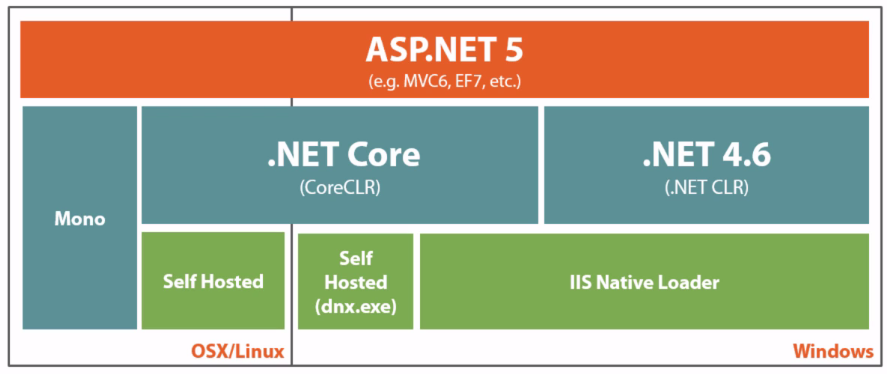Introduction to the ASP.NET Runtime
ASP.NET is an open-source server-side web application framework designed for web development to produce dynamic webpages. That’s what Wikipedia says about it anyway… I personally had no clue what it was until I recently began taking a course that was available as part of the free 6 months worth of Pluralsight I picked up from the Visual Studio Dev Essentials pack.
Three Frameworks
There are three frameworks available, each of them seamlessly integrate with one and other and provide different levels of functionality.

.NET 4.6 is the .NET we’ve always known. It was built for the windows platform so it didn’t natively function on other systems. This is where Mono came in.
Mono is a community driven project that allows .NET code to run on OSX/Linux systems. It is still widely used and very popular.
.NET Core is the most recent edition to the .NET family. It’s open source like Mono but supports both Windows, OSX and Linux platforms.
- CoreCLR is a subset of the .NET Framework.
Installing ASP.NET
- Start by first installing Visual Studio 2015 if you haven’t already got it on your system.
- The install process can be quite lengthy, maybe go get 5-6 cups of coffee while you wait.
-
Download and install
ASP.NET 5from here. - You will now have access to the
DNVMcmdlet. Running the following command will display a full list of commands you have access to.
C:\Users\Nathan>dnvm
___ _ ___ ____ ___
/ _ \/ |/ / | / / |/ /
/ // / /| |/ / /|_/ /
/____/_/|_/ |___/_/ /_/
.NET Version Manager v1.0.0-rc1-15540
By Microsoft Open Technologies, Inc.
usage: dnvm <command> [<arguments...>]
Current feed settings:
Default Stable: https://www.nuget.org/api/v2
Default Unstable: https://www.myget.org/F/aspnetvnext/api/v2
Current Stable Override: <none>
Current Unstable Override: <none>
To use override feeds, set DNX_FEED and DNX_UNSTABLE_FEED environment keys respectively
commands:
alias Lists and manages aliases
exec Executes the specified command in a sub-shell where the PATH has been augmented to include the specified DNX
help Displays a list of commands, and help for specific commands
install Installs a version of the runtime
list Lists available runtimes
run Locates the dnx.exe for the specified version or alias and executes it, providing the remaining arguments to dnx.exe
setup Installs the version manager into your User profile directory
uninstall Uninstalls a version of the runtime
update-self Updates DNVM to the latest version.
upgrade Installs the latest version of the runtime and reassigns the specified alias to point at it
use Adds a runtime to the PATH environment variable for your current shell
version Displays the DNVM version.Setting up
Running the command dnvm list from command line will result in a list of the current versions of ASP.NET 5 you currently have installed on your system
C:\Users\Nathan>dnvm list
Active Version Runtime Architecture OperatingSystem Alias
------ ------- ------- ------------ --------------- -----
* 1.0.0-rc1-update1 clr x64 win default
1.0.0-rc1-update1 clr x86 win
1.0.0-rc1-update1 coreclr x64 win
1.0.0-rc1-update1 coreclr x86 winThese runtimes are stored in your user directory, and you can prove this by listing the files in .dnx\runtimes. Run the following to show a list of installed runtimes under your home directory.
C:\Users\Nathan>dir .dnx\runtimes
Volume in drive C has no label.
Volume Serial Number is 2A20-B603
Directory of C:\Users\Nathan\.dnx\runtimes
11/12/2015 12:02 AM <DIR> .
11/12/2015 12:02 AM <DIR> ..
10/12/2015 11:56 PM <DIR> dnx-clr-win-x64.1.0.0-rc1-update1
10/12/2015 11:45 PM <DIR> dnx-clr-win-x86.1.0.0-rc1-update1
11/12/2015 12:01 AM <DIR> dnx-coreclr-win-x64.1.0.0-rc1-update1
11/12/2015 12:02 AM <DIR> dnx-coreclr-win-x86.1.0.0-rc1-update1
0 File(s) 0 bytes
6 Dir(s) 44,004,626,432 bytes freeYou can also run dnvm upgrade in order to pull down the most recent versions of the ASP.NET 5 runtime. If there is a more recent runtime available it will be downloaded and set as your default runtime.
C:\Users\Nathan>dnvm upgrade
Determining latest version
'dnx-clr-win-x86.1.0.0-rc1-update1' is already installed in C:\Users\Nathan\.dnx\runtimes\dnx-clr-win-x86.1.0.0-rc1-update1.
Adding C:\Users\Nathan\.dnx\runtimes\dnx-clr-win-x86.1.0.0-rc1-update1\bin to process PATH
Adding C:\Users\Nathan\.dnx\runtimes\dnx-clr-win-x86.1.0.0-rc1-update1\bin to user PATH
Updating alias 'default' to 'dnx-clr-win-x86.1.0.0-rc1-update1'You can also manually pull down other versions using the following in order to support different architectures.
dnvm install 1.0.0-rc1-update1 -arch x64You might also want the coreclr versions, in which case you can run the following to pull down the respective version. Do the same for the x86 version.
dnvm install 1.0.0-rc1-update1 -r coreclr
dnvm install 1.0.0-rc1-update1 -r coreclr -arch x86With a full suite of runtimes installed, you can now use the following command to switch between runtimes.
dnvm use 1.0.0-rc1-update1 -r clr -arch x64 -pNote that the -p makes the path persistent so you won’t need to re-run the command each time you open a new terminal
Running dnx --version will show you the runtime currently active
C:\Users\Nathan>dnx --version
Microsoft .NET Execution environment
Version: 1.0.0-rc1-16231
Type: Clr
Architecture: x86
OS Name: Windows
OS Version: 10.0
Runtime Id: win10-x86Hello World
At this stage we are ready to use the runtime we just installed. In order to do this you’ll need to create two new files in a working directory with the following contents
project.json
Specifies the framework we want to use. can also contain other project based traits (you’ll see this in up-comming tutorials)
{
"frameworks":
{
"dnx451":{}
}
}program.cs
Contains straight C# code.
using System;
public class Program
{
public void Main()
{
Console.WriteLine("Hello World");
}
}And that’s it!. You can run your Hello World using the following syntax:
C:\Users\Nathan\OneDrive\02 - Code\15 - ASP.NET\helloWorld>dnx run program.cs
Hello WorldSummary
As someone new to the .NET scene I was astounded by how simple it was to get started with ASP.NET and I can’t wait to get my fingers into some more difficult challenges. I would highly recommend checking out the course I wrote this for; and even follow along with me as I make my way through the several hours worth of FREE content.